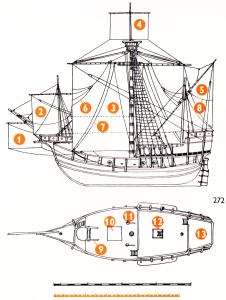 Columbus’ flagship, Santa Maria, ran aground and sank on Christmas Day 1492 off Haiti, on Columbus’ first voyage to the New World. Now after more than a decade’s research, underwater explorer Barry Clifford believes that he has found the wreck of Columbus’ ship. The wreck was originally discovered in 2003, but was not initially ruled out. Clifford told CNN, archaeologists at the time “misdiagnosed” the cannon found on the wreck. Clifford said, “Every single piece fits. Now, of course, we have to go through the whole archeological process, and we plan to do that within the next few months, but I feel very confident that we’ve discovered the site.”
Columbus’ flagship, Santa Maria, ran aground and sank on Christmas Day 1492 off Haiti, on Columbus’ first voyage to the New World. Now after more than a decade’s research, underwater explorer Barry Clifford believes that he has found the wreck of Columbus’ ship. The wreck was originally discovered in 2003, but was not initially ruled out. Clifford told CNN, archaeologists at the time “misdiagnosed” the cannon found on the wreck. Clifford said, “Every single piece fits. Now, of course, we have to go through the whole archeological process, and we plan to do that within the next few months, but I feel very confident that we’ve discovered the site.”
The press is reporting that the wreck site consists of a pile of ballast stones roughly 40′ long by 20′ wide which they say “corresponds to the likely dimensions of the Santa Maria.” In fact, there is little agreement on the dimensions of the ship.
Santa María was built in Castro-Urdiales, Cantabria, in Spain’s northeast region and was probably a medium-sized nau, also known as a carrack, of roughly 100 tuns burthen. The Santa María had a single deck and three masts. Beyond that, not much is really known about the ship. Björn Landström, writing in his book The Ship, discusses the problem in estimating the dimensions of the ship:
An old rule of thumb for shipbuilders was that a vessel’s measurement thwartships, length of keel and lenght from stem to stern ought roughly to be in the proportions 1:2:3. If we had one of these measurements it would have been easy to work out the approximate proportions of the Santa Maria, but we have only been able to guess at her draught and the number of tuns of wine she could carry. In order to reconstruct a vessel of roughly the correct size it has been necessary to guess what remains:
Length from stem to stern 78 1/2 feet,
Length of keel 55 1/2 feet
Breadth 26 feet.
Total sail area about 3,500 sq. feet, of which the mainsail plus its two bonnets would have been about 2,200 sq. feet.
Other estimates of the ship size are both largest and smaller. The replica built for the city of Columbus, Ohio, which is claimed to be “the world’s most authentic, museum-quality representation of Christopher Columbus’ flagship” is 98′ long overall, 72′ on the waterline with a breadth of 26′. The Encyclopedia Britannica lists the length as about 117′ while the Wikipedia entry suggests a hull length of 68′ and a breadth of only 18′.
Landström drew his impression of the ship’s layout and rig based on the original description and drawings of similar ships from the time. The figures in his drawing above refer to the following:
- Spritsail.
- Foresail.
- Mainsail with bonnets.
- Topsail.
- Mizzen.
- Martnet.
- Clewline.
- Clewline.
- Windlass.
- Hatch.
- Pump.
- Ladder from quarter-deck. to main deck.
- Half deck.

I first visited Cap Haitian, Haiti in 1970. At that time we were discussing development of the Port for cruise ships which would come in the future. We discussed wrecks in the area, made and positioned navigation buoys in the approach channel (which were regularly stolen!!) One of the wrecks pointed out down towards the border with the Dominican Republic we were told was the Santa Maria.
Good Watch.